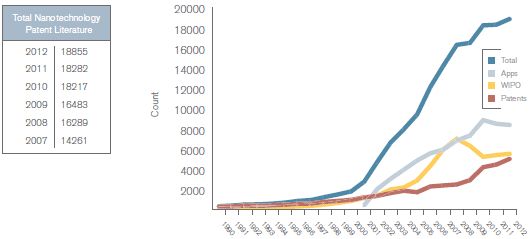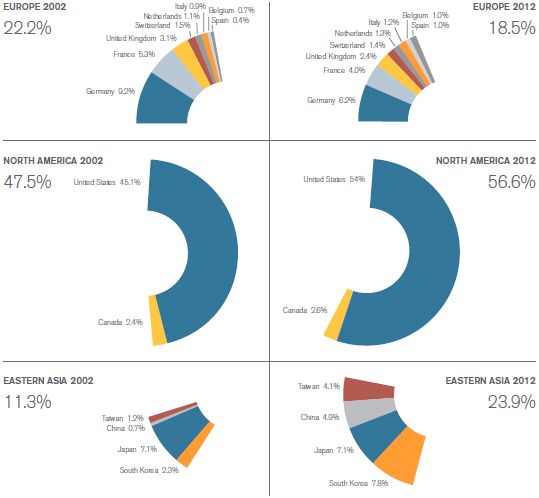INTRODUCTION
"McDermott's analysis of the 2012 nanotechnology patent literature indicates the United States is once again the global leader in nanotechnology."
The world is transitioning from a computer revolution to a technology revolution driven by nanotechnology and molecular manufacturing. Politicians, government agencies and industry executives alike recognize this critical technological transition:
"Nanotechnology is going to change America on a scale equal to, if not greater than, the computer revolution. Harnessing the power of nanotechnology is one of the keys to ensuring that our nation continues to be an economic powerhouse in this new century."
—U.S. Senator Ron Wyden (D-OR)1
"We see [nanotechnology] as having virtually unlimited potential to transform the way we produce, deliver and use energy, not to mention its likely effect on medical technology and national security."
—Spencer Abraham, Former U.S. Secretary of Energy2
"Nanotechnology is the base technology of an industrial revolution in the 21st century. Those who control nanotechnology will lead the industry."
—Michiharu Nakamura, Executive Vice President of Hitachi China Ltd.3
This technology transition was the topic of McDermott Will & Emery's 2012 nanotechnology report entitled "Nanotechnology: Who will be the leaders in the fifth technology revolution?"4 McDermott's analysis of the 2011 nanotechnology patent literature found that the United States is poised to be a global leader in nanotechnology, given its high levels of research, development and funding, and diversification of those industry sectors affected by nanotechnology. However, the report also considered the question of whether the United States would soon be surpassed by other rapidly developing countries, such as China and India. This year's findings reveal that the United States has, in fact, maintained the lead.
Key Highlights of 2012
- In total, the volume of nanotechnology patent literature
published in 2012 was 3 percent greater than that of 2011,
including approximately 550 more U.S. patents being granted in 2012
compared to 2011.
- The United States again leads the world in nanotechnology
patent literature, which is an indicator of nanotechnology
innovation.
- Eastern Asia, especially China and South Korea, have seen some
of the greatest growth in nanotechnology patent literature over the
last decade.
- U.S.-based companies are the top assignees in nanotechnology
patent literature, with emphases in the Computers and Electronics,
Materials, Chemistry, Biological Sciences, Metrology and
Instrumentation, and Energy sectors.
Nanotechnology
Nanotechnology is often described as the understanding and control of matter at the nanoscale (approximately 1 nanometer to 100 nanometers in length). It encompasses nanoscale science, engineering and technology, and involves imaging, measuring, modeling and manipulating matter at the nanometer (nm) length scale.5
Similar to computers, nanotechnology is both an enabling technology and a technology sector in its own right. Nanotechnology is prolific in the research and development of almost every economic sector, from aerospace to medicine to energy. Further, many commercial products incorporate nanomaterials or nanotechnology principles. For example, incorporation of silver nanoparticles into wound dressings provides antibacterial properties. Manufacturers of sports equipment and automobiles can use nanoparticles to decrease weight and increase strength of composites used in the manufacturing of their products. Paints often include nanoparticles to enhance the color, reduce or eliminate volatile organic compounds, and stop bacteria or fungal growth, which may be particularly useful in hospitals and clinics.
Worldwide Nanotechnology Growth
GROWTH OF NANOTECHNOLOGY PATENT LITERATURE

Since the early 2000s, nanotechnology patent literature6 has experienced exponential growth. This corresponds to a periodduring which several government initiatives worldwide increased funding for and education about nanotechnology. For example, the United States launched the National Nanotechnology Initiative (NNI) in 2000 in cooperation with eight other U.S. agencies. The NNI increased nanotechnology funding from about $220 million in 2000 to around $950 million in 2005, and to more than $1.8 billion in 2012, distributed over 26 federal agencies. In 2001, Japan prioritized nanotechnology by sharply increasing funding levels from $400 million in 2001 to about $800 million in 2003. In a similar fashion, in the early 2000s South Korea set out to implement a 10-year, $2 billion nanotechnology program, and Taiwan committed around $600 million over six years. During a similar period, the estimated funding in the European Union (EU) countries grew from around $250 million in 1997 to about $1.3 billion in 2004.7
Regional Leaders in Nanotechnology Innovation
Regional nanotechnology innovation can be assessed through nanotechnology patent literature in two ways: by analyzing the location of the inventors, and by analyzing the location of the assignees. The first is an indicator of where the nanotechnology talent is accumulated. The second is an indicator of where the entities that support and fund nanotechnology are located, which may also indicate the regions that have an opportunity to reap many of the economic benefits.
Generally, one would expect the two analyses to correlate directly. However, in reviewing the data, there are several countries, including the United States, where a significant portion of the research resulting in patent literature is a result of assignees funding collaborative efforts with inventors from other countries. For example, more than 130 nanotechnology patent literature documents were published in 2012 with inventors in both the United States and Germany and more than 120 for the United States and China.
GEOGRAPHICAL BREAKDOWN OF 2012 NANOTECHNOLOGY PATENT LITERATURE | BASED ON INVENTOR RESIDENCE

*Countries in these regions whose nanotechnology patent literature accounted for less than 1 percent of the total patent literature in 2012 are not included in this chart. The only two countries not in these regions, but with more than 1 percent of the total patent literature in 2012, are India (with 1.5 percent) and Israel (with 1.2 percent).
GEOGRAPHICAL BREAKDOWN OF 2012 NANOTECHNOLOGY PATENT LITERATURE

Looking at the bigger picture, the inventor and assignee location information clearly illustrates that the United States leads nanotechnology innovation. However, the United States also appears to be declining slightly in the percentage of nanotechnology innovation that is assigned to U.S. entities. Eastern Asia has significantly increased its nanotechnology patent literature presence over the last 10 years, in inventorship and in assignee percentages. Europe has held relatively steady, with countries such as Spain and Belgium increasing in inventorship and in assignee percentages.
Digging deeper into regional nanotechnology innovation, an analysis of the top 15 assignees shows that the United States, with nine assignees, is in the lead, followed by Eastern Asia with four, and finally Europe with two (see chart on next page). Compared to last year's top assignee list, Computers and Electronics, and Universities and Government Agencies, remain the two most-represented sectors. The top five assignees are also the same as last year, with minor ranking changes for Samsung. In addition, the top two climbers on the list are Baker Hughes (moving from 22nd to 11th position) and General Electric (moving from 14th to 9th position).
TOP ASSIGNEES IN 2012 NANOTECHNOLOGY PATENT LITERATURE
|
ASSIGNEE |
COUNTRY |
SECTORS |
|||
|
1 |
IBM |
United States |
Computers and Electronics |
||
|
2 |
Samsung |
South Korea |
Computers and Electronics |
||
|
3 |
Hon Hai Precision Industry |
Taiwan |
Computers and Electronics |
||
|
4 |
Tsinghua University |
China |
Computers and Electronics |
||
|
5 |
University of California |
United States |
University and Government |
||
|
6 |
Xerox |
United States |
Computers and Electronics |
||
|
7 |
Massachusetts Institute of Technology |
United States |
University and Government |
||
|
8 |
3M |
United States |
Consumer Products |
||
|
9 |
General Electric Company |
United States |
Energy, Healthcare, and Consumer Products |
||
|
10 |
Atomic and Alternative Energies Commission |
France |
Energy |
||
|
11 |
Baker Hughes |
United States |
Energy |
||
|
12 |
National Center for Scientific Research |
France |
University and Government |
||
|
13 |
Micron Technology, Inc. |
United States |
Computers and Electronics |
||
|
14 |
Toshiba |
Japan |
Computers and Electronics |
||
|
15 |
DuPont |
United States |
Chemical |
||
Technology Trends in Nanotechnology Innovation
Continuing to dig deeper into nanotechnology innovation, we reviewed the growth of general technology types. The methodology was to assign International Patent Classification classes to a technology sector.8,9
Similar to the trends of nanotechnology patent literature as a whole, each of the technology types began to experience exponential growth in the early 2000s. Not surprisingly, the area of Computers and Electronics has seen the greatest increase, as computers continue to shrink and transition from traditional top-down technologies to nanotechnological bottom-up technologies. For the same reasons, the top assignees in this technology area—IBM, Hon Hai Precision Industry and Samsung—are fairly predictable.
The technology areas of Chemistry and Materials are the second-most prevalent. Both areas serve, at least in part, as a platform for many other technologies, as each include the synthesis of nanoparticles and engineering of nanomaterials that can then be applied to other technological advancements.
The Biological Sciences technical area, which encompass biochemistry, medicine, veterinary science and agriculture, is also performing well, followed by Metrology and Instrumentation. Like Chemistry and Materials, Metrology and Instrumentation serves in part as a platform technology—but it is also a niche technology, which helps explain the lower count. Based on a cursory review of the nanotechnology patent literature for Energy Generation, Transmission and Storage, this technological area may be more prevalent than indicated, as many nanoparticles and nanomaterials that would fall within this technical area may also be classified in the Chemistry and Materials areas, e.g., materials suitable for use in batteries, solar panels and energy transmission.
TECHNOLOGY BREAKDOWN OF 2012 NANOTECHNOLOGY PATENT LITERATURE

TOP ASSIGNEES IN 2012 NANOTECHNOLOGY PATENT LITERATURE BY TECHNOLOGY
|
COMPUTERS |
COUNTRY |
||
|
1 |
IBM |
United States |
|
|
2 |
Hon Hai Precision Industry |
Taiwan |
|
|
3 |
Samsung |
South Korea |
|
|
MATERIALS |
|||
|
1 |
Hon Hai Precision Industry |
Taiwan |
|
|
2 |
Tsinghua University |
China |
|
|
3 |
Samsung |
South Korea |
|
|
CHEMISTRY |
|||
|
1 |
University of California |
United States |
|
|
2 |
Baker Hughes |
United States |
|
|
3 |
National Center for Scientific Research |
France |
|
|
BIOLOGICAL SCIENCES INCLUDING MEDICINE AND AGRICULTURE |
|||
|
1 |
University of California |
United States |
|
|
2 |
Selecta Biosciences |
United States |
|
|
3 |
Massachusetts Institute of Technology |
United States |
|
|
METROLOGY AND INSTRUMENTATION |
|||
|
1 |
University of California |
United States |
|
|
2 |
Massachusetts Institute of Technology |
United States |
|
|
3 |
Samsung |
South Korea |
|
|
ENERGY |
|||
|
1 |
Baker Hughes |
United States |
|
|
2 |
Hon Hai Precision Industry |
Taiwan |
|
|
3 |
Samsung |
South Korea |
|
A review of the top three assignees in each of the identified technology areas further illustrates the dominance and diversity of the United States and, secondarily, Eastern Asia, especially in the area of Computers and Electronics and, by extension, Materials.
Conclusions
As the world transitions from a computer technology revolution to a revolution based on nanotechnology and molecular assembly, it may still be too early to tell where the global epicenters will be. However, the United States continues in its position as a world leader, due in large part to its high levels of research, development and funding, and the diversity of its economic sectors affected by nanotechnology.
Footnotes
1 "Nanotech Quote Collection," Inside Nanotechnology, Newbridge Institutional Research, accessed February 5, 2013, http://www.newbridgereports.com/quotes.html.
2 Ibid.
3 Ibid.
4 Available at http://www.mwe.com/files/Uploads/Documents/Pubs/Nanotechnology2.pdf.
5 National Nanotechnology Initiative at www.nano.gov.
6 "Nanotechnology patent literature" is defined as U.S. Published Patent Applications, U.S. Granted Patents and Published International Patent Applications having the term "nano*" in the claims, title or abstract. While the U.S. Patent Office (USPTO) has a nanotechnology class, specifically Class 977, the results of searching only Class 977 were found to be too narrow and did not apply to International Patent Applications.
7 Funding estimates from the NNI at www.nano.gov and "Toward a European Strategy for Nanotechnology," a 2004 communication from the European Commission.
8 "Biological Sciences: A01, A61, B82Y5, C12 and C40Chemistry: B01, B03, B04, C01, C02, C06, C07, C08, C09, C10, C11, C13, C25 and C30Computers and Electronics: B32, B81, B82Y10, G06, G11, H01B, H01C, H01F, H01G, H01H, H01J, H01L, H01R, H01S, H01T, H03, H04 and H05Energy Generation, Transmission and Storage: E21, E04D, F02, F03, F22, H02, H01M and H01PMaterials: B05, B07, B21, B22, B23, B24, B25, B26, B27, B28, B29, B31, B82B, B82Y20, B82Y25, B82Y30, B82Y40, C03, C04, C14, C21, C22, C23, D01, D02, D03, D04, D05, D06, D07, D21, F16 and F28Metrology and Instrumentation: B82Y15, B82Y35, G01, G02 and G12
9 It should be noted that individual nanotechnology patent literature documents may be associated with more than one international class, which will allow for the summation of these counts to be greater than the number of total nanotechnology patent literature for a given year. To mitigate individual nanotechnology patent literature documents being counted twice in a single technology, searches were preformed to include all classes corresponding to the technology of interest. Further, this methodology was not employed in McDermott's 2012 report. Therefore, direct comparisons between this analysis and the analysis of the 2011 nanotechnology patent literature in that report would be improper.
The content of this article is intended to provide a general guide to the subject matter. Specialist advice should be sought about your specific circumstances.


